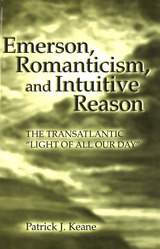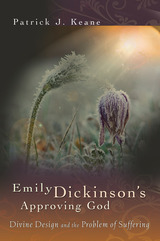2 books by Keane, Patrick J.

Patrick J. Keane
University of Missouri Press
Emerson, Romanticism, and Intuitive Reason is a comparative study in transatlantic Romanticism, focusing on Emerson’s part in the American dialogue with British Romanticism and, as filtered through Coleridge, German Idealist philosophy. The book’s guiding theme is the concept of intuitive Reason, which Emerson derived from Coleridge’s distinction between Understanding and Reason and which Emerson associated with that “light of all our day” in his favorite stanza of Wordsworth’s “Ode: Intimations of Immortality.” Intuitive Reason became the intellectual and emotional foundation of American Transcendentalism. That light radiated out to illuminate Emerson’s life and work, as well as the complex and often covert relationship of a writer who, however fiercely “self-reliant” and “original,” was deeply indebted to his transatlantic precursors.
The debt is intellectual and personal. Emerson’s supposed indifference to, or triumph over, repeated familial tragedy is often attributed to his Idealism—a complacent optimism that blinded him to any vision of the tragic. His “art of losing” may be better understood as a tribute to the “healing power,” the consolation in distress, which Emerson considered Wordsworth’s principal value. The second part of this book traces Emerson’s struggle—with the help of the “benignant influence” shed by that “light of all our day”—to confront and overcome personal tragedy, to attain the equilibrium epitomized in Wordsworth’s “Elegiac Stanzas”: “Not without hope we suffer and we mourn.”
As a study in what has been called “the paradox of originality,” the book should appeal to those interested in the Anglo-American Romantic tradition and the innovations of the individual talent—especially in the capacity of a writer such as Emerson not only to absorb his precursors but also to use them as a stimulus to his own creative power.
[more]

Patrick J. Keane
University of Missouri Press
As much a doubter as a believer, Emily Dickinson often expressed views about God in general—and God with respect to suffering in particular. In many of her poems, she contemplates the question posed by countless theologians and poets before her: how can one reconcile a benevolent deity with evil in the world?
Examining Dickinson’s perspectives on the role played by a supposedly omnipotent and all-loving God in a world marked by violence and pain, Patrick Keane initially focuses on her poem “Apparently with no surprise,” in which frost, a “blonde Assassin,” beheads a “happy Flower,” a spectacle presided over by “an Approving God.” This tiny lyric,Keane shows, epitomizes the poet’s embattled relationship with the deity of her Calvinist tradition.
Although the problem of sufferingis usually couched in terms of natural disasters or human injustice, Dickinson found new ways of considering it. By choosing a flower as her innocent “victim,” she bypassed standard “answers” to the dilemma (suffering as justified punishment for wickedness, or as attributable to the assertion of free will) in order to focus on the problem in its purest symbolic form. Keane goes on toprovide close readings of many of Dickinson’s poems and letters engaging God, showing how she addressed the challenges posed—by her own experience and by an innate skepticism reinforced by a nascent Darwinism—to the argument from design and the concept of a benevolent deity.
More than a dissection of a single poem, Keane’s book is a sweeping personal reflection on literature and religion, faith and skepticism, theology and science. He traces the evolving history of the Problem of Suffering from the Hebrew Scriptures (Job and Ecclesiastes), through the writings of Paul, Augustine, and Aquinas, to the most recent theological and philosophical studies of the problem. Keane is interested in how readers today respond to Emily Dickinson’s often combative poems about God; at the same time, she is located as a poet whose creative life coincided with the momentous changes and challenges to religious faith associated with Darwin andNietzsche.Keane also considers Dickinson’s poems and letters in the context of the great Romantic tradition, as it runs fromMilton throughWordsworth, demonstrating how thework of these poets (perhaps surprisingly in the case of the latter)helps illuminate Dickinson’s poetry and thought.
Because Dickinson the poet was also Emily the gardener, her love of flowers was an appropriate vehicle for her observations on mortality and her expressions of doubt. Emily Dickinson’s Approving God is a graceful study that reveals not only the audacity of Dickinson’s thought but also its relevance to modern readers. In light of ongoing confrontations between Darwinism and design, science and literal conceptions of a divine Creator, it is an equally provocative read for students of literature and students of life.
[more]
READERS
Browse our collection.
PUBLISHERS
See BiblioVault's publisher services.
STUDENT SERVICES
Files for college accessibility offices.
UChicago Accessibility Resources
home | accessibility | search | about | contact us
BiblioVault ® 2001 - 2024
The University of Chicago Press









